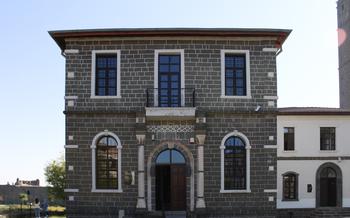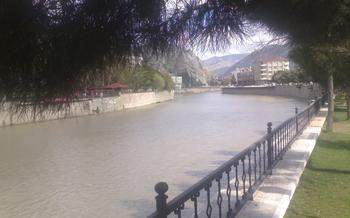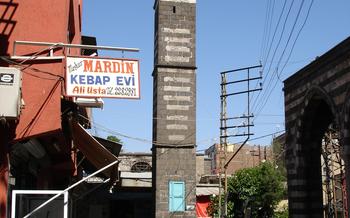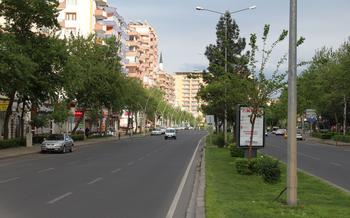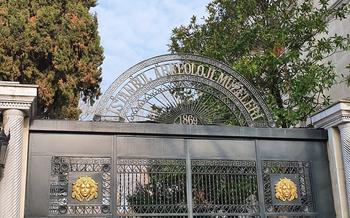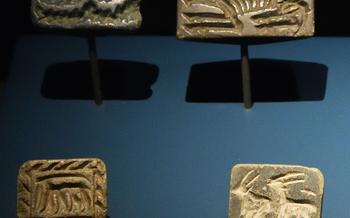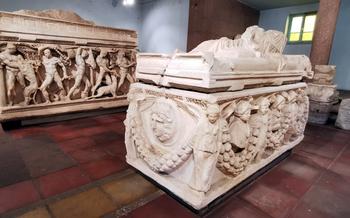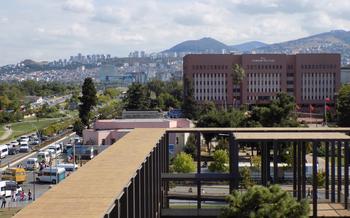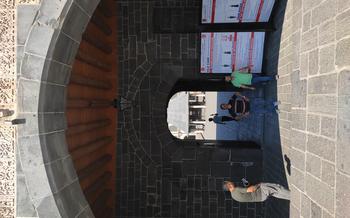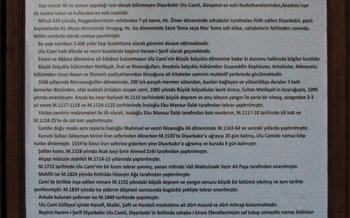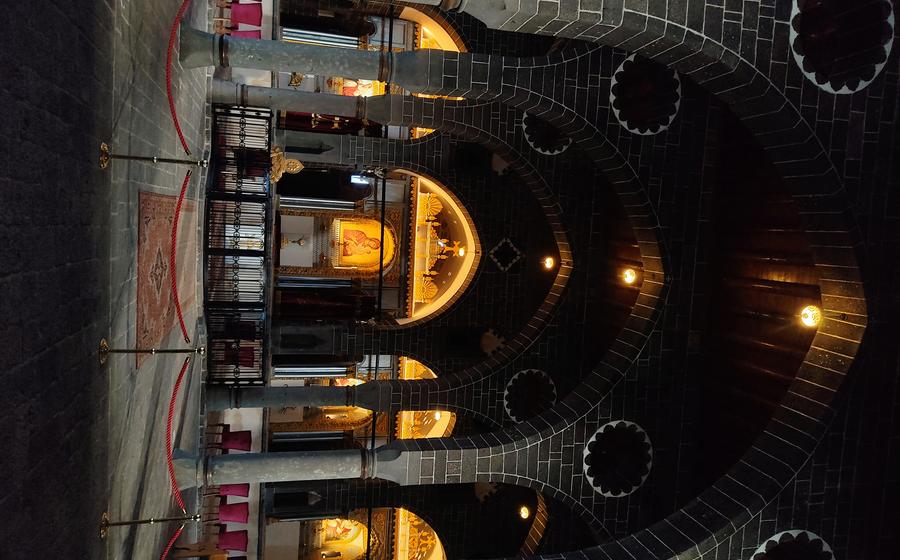
Diyarbakır Archeology Museum
- Diyarbakır Archeology Museum: A Journey Through History
- Step Back in Time: The Neolithic Era
- Unraveling the Mysteries of the Bronze Age
- The Assyrian Dominance: A Legacy of Power
- Witnessing the Hellenistic and Roman Periods
- The Islamic Conquest: A New Era Begins
- The Seljuk and Artuqid Dynasties: A Period of Prosperity
- The Ottoman Empire: A Lasting Legacy
- The Modern Era: A City of Resilience
- A Treasure Trove of Artifacts: Highlights of the Museum's Collection
- Engaging Activities for Visitors: Beyond the Exhibits
- Practical Tips for a Smooth Visit
- Recommended Nearby Attractions: Enrich Your Experience
- Insider Tip: Discover the Hidden Gem
Diyarbakır Archeology Museum: A Journey Through History
Nestled in the heart of the ancient city of Diyarbakır, the Diyarbakır Archeology Museum stands as a testament to the region's rich and diverse cultural heritage. This remarkable institution houses a vast collection of artifacts that span millennia, offering visitors a captivating journey through history. The museum's architectural grandeur is a sight to behold, showcasing intricate stone carvings and traditional Islamic motifs that reflect the city's unique blend of cultures.
Inside, visitors are greeted by a treasure trove of artifacts that tell the story of Diyarbakır's past. From prehistoric tools and pottery to exquisite Assyrian reliefs and Islamic calligraphy, the museum's collection is a testament to the region's vibrant history. The museum also plays a crucial role in preserving and promoting Turkish heritage, ensuring that the stories and traditions of Diyarbakır are passed on to future generations.
Step Back in Time: The Neolithic Era
The Diyarbakır Archeology Museum houses a remarkable collection of artifacts that shed light on the Neolithic era, a pivotal period in human history. During this time, the region witnessed the emergence of the first settled communities and the development of agriculture. Neolithic people laid the foundation for future civilizations, and their tools, weapons, and pottery provide valuable insights into their lifestyle, economy, and social structure.
One of the most intriguing aspects of the Neolithic era is the development of stone tools. The museum showcases a variety of these tools, including hand axes, scrapers, and arrowheads. These tools were essential for hunting, gathering, and processing food. The museum also displays a collection of pottery from this period, which reveals the artistic skills and craftsmanship of Neolithic people.
The Neolithic era was a time of significant social and economic changes. The transition from a nomadic lifestyle to settled communities led to the development of agriculture and animal domestication. The museum's collection includes evidence of these changes, such as grinding stones, sickles, and animal bones. These artifacts provide a glimpse into the daily lives of Neolithic people and their struggle to adapt to a new way of life.
The Neolithic era marked the beginning of human civilization, and the Diyarbakır Archeology Museum's collection offers a fascinating journey into this transformative period. By studying the tools, weapons, and pottery of Neolithic people, we gain a deeper understanding of their culture, society, and the foundations they laid for future generations.
Unraveling the Mysteries of the Bronze Age
The Bronze Age in the Diyarbakır region marked a transformative period characterized by the rise of powerful empires and kingdoms. During this era, significant technological advancements, such as metallurgy and writing, emerged, revolutionizing various aspects of life. These advancements facilitated the development of more sophisticated tools, weapons, and systems of communication, leading to increased productivity and societal organization.
Cultural exchange and interactions among different civilizations were prevalent during the Bronze Age. The region served as a crossroads for diverse cultures, resulting in a rich blend of artistic styles, religious beliefs, and social practices. This cultural fusion left a lasting impact on the region's identity and contributed to the development of a unique cultural heritage.
The legacy of the Bronze Age in the Diyarbakır region is evident in the numerous artifacts and remnants that have been discovered and preserved. These findings provide valuable insights into the social, economic, and cultural dynamics of this era. They shed light on the daily lives of the people, their technological capabilities, and their interactions with the surrounding world.
Understanding the Bronze Age in the Diyarbakır region is crucial for comprehending the historical trajectory of the region and its role in shaping the broader cultural landscape of Mesopotamia. The artifacts and knowledge gained from this period continue to inspire and inform researchers, historians, and archaeologists, contributing to our understanding of the roots of civilization.
The Assyrian Dominance: A Legacy of Power
The Diyarbakır Archeology Museum houses a remarkable collection of artifacts that provide a glimpse into the grandeur and power of the Assyrian Empire. The Assyrians, known for their military prowess and administrative efficiency, ruled over a vast territory that included the Diyarbakır region. Their influence is evident in the impressive sculptures, reliefs, and cuneiform tablets that adorn the museum's Assyrian section.
One of the highlights of the collection is a colossal statue of a winged bull with a human head, a symbol of strength and authority. The intricate details and lifelike features of the statue are a testament to the skill and artistry of Assyrian craftsmen. Another notable artifact is a series of reliefs depicting scenes of warfare, royal hunts, and religious ceremonies. These reliefs offer valuable insights into the daily life, customs, and military campaigns of the Assyrian Empire.
Diyarbakır served as an important administrative center for the Assyrian province of Tur Abdin. The city's strategic location on the trade routes between Mesopotamia and Anatolia made it a crucial hub for economic and political activities. The Assyrians left a lasting impact on the region, contributing to its cultural and infrastructural development. Their legacy can still be seen in the ancient ruins and artifacts that are carefully preserved in the Diyarbakır Archeology Museum.
Witnessing the Hellenistic and Roman Periods
The Hellenistic and Roman periods left a significant mark on the Diyarbakır region. During the Hellenistic era, the influence of Greek culture and art can be seen in various aspects of life. From sculptures and pottery to architecture, Hellenistic influences permeated the region's artistic and cultural expression.
The Roman Empire's presence in the region brought about significant advancements in infrastructure and urban planning. Well-preserved Roman structures, such as theaters and baths, stand as testaments to the empire's engineering prowess and architectural legacy. These structures showcase the Romans' attention to detail, functionality, and aesthetics.
The fusion of local traditions with Hellenistic and Roman influences during this period resulted in a unique blend of cultural elements. This cultural exchange enriched the region's heritage and contributed to the diverse tapestry of customs and traditions that characterize Diyarbakır today.
The Islamic Conquest: A New Era Begins
The arrival of Islam in the Diyarbakır region marked a significant turning point in its history. The new faith brought with it a fresh wave of cultural and intellectual influences, leaving an indelible imprint on the region's identity. Diyarbakır emerged as a prominent center of Islamic learning and scholarship, attracting renowned scholars and theologians from across the Islamic world.
One of the most striking legacies of the Islamic period is the magnificent architecture that adorns the city. Mosques, madrasas, and mausoleums were constructed with intricate artistry and craftsmanship, showcasing the fusion of Islamic design with local traditions. These architectural masterpieces, such as the Great Mosque of Diyarbakır, stand as testaments to the region's rich Islamic heritage.
The Islamic period also witnessed the flourishing of Sufi traditions, with Diyarbakır becoming a hub for Sufi orders and practices. Sufism, with its emphasis on spirituality and mysticism, deeply influenced the cultural and intellectual landscape of the region. The presence of Sufi shrines and tekkes (Sufi lodges) added to the city's spiritual significance, attracting pilgrims and devotees from far and wide.
Diyarbakır, as a cultural and intellectual center, played a pivotal role in the transmission of knowledge and ideas throughout the Islamic world. Scholars and students from across the region flocked to the city's libraries and madrasas, seeking knowledge in various fields, including Islamic law, theology, literature, and philosophy.
The Islamic conquest marked a period of profound transformation for Diyarbakır, ushering in a new era of cultural and intellectual vibrancy. The city's rich Islamic heritage continues to shape its identity and remains a source of pride for its inhabitants.
The Seljuk and Artuqid Dynasties: A Period of Prosperity
During the 11th and 12th centuries, the Seljuk and Artuqid dynasties ruled over the Diyarbakır region, ushering in a period of economic prosperity and cultural flourishing. The Seljuks, known for their architectural prowess, constructed numerous magnificent structures, including the iconic Great Mosque of Diyarbakır, a testament to their architectural mastery. The Artuqids, on the other hand, were renowned for their patronage of the arts and sciences, establishing Diyarbakır as a cultural and intellectual hub.
The legacy of the Seljuk and Artuqid dynasties is evident in the region's rich artistic traditions. Seljuk craftsmanship is characterized by intricate geometric patterns and decorative motifs, as seen in the exquisite tilework and woodwork adorning their buildings. The Artuqids, known for their metalworking skills, produced stunning artifacts, such as finely crafted jewelry and intricate metalwork objects.
The Seljuk and Artuqid periods were also marked by economic growth and stability. The region's strategic location along trade routes facilitated commerce and cultural exchange, contributing to the prosperity of Diyarbakır. This era saw the establishment of bustling markets, the development of agriculture, and the flourishing of traditional crafts.
The Seljuk and Artuqid dynasties left an indelible mark on the region's history and culture. Their contributions to architecture, art, and economic development laid the foundation for Diyarbakır's rich cultural heritage, which continues to captivate visitors to this day.
The Ottoman Empire: A Lasting Legacy
The Ottoman Empire, with its vast reach and enduring influence, played a significant role in the history of Diyarbakır. The city served as an important administrative center during the Ottoman period, further solidifying its position as a strategic hub. Under Ottoman rule, Diyarbakır witnessed the construction of numerous cultural and architectural landmarks that stand as testaments to the empire's legacy. Among these landmarks are impressive mosques, such as the Fatih Pasha Mosque, and caravanserais, which were essential for trade and travel. The Ottomans also contributed to the city's urban development, leaving an indelible mark on its physical and cultural landscape.
During the Ottoman era, local traditions and influences blended harmoniously with those of the empire, creating a rich tapestry of cultural exchange. This fusion is evident in various aspects of Diyarbakır's culture, from cuisine to architecture. The city's cuisine, for instance, incorporates both Turkish and local flavors, resulting in a unique culinary experience. The architectural heritage of Diyarbakır also reflects this blend, with Ottoman-style buildings standing alongside traditional structures, creating a visually captivating urban environment.
The Modern Era: A City of Resilience
Diyarbakır today stands as a testament to resilience, having weathered historical storms and emerged as a vibrant and diverse city. It is a cultural melting pot, home to people of various ethnicities and religions who have woven their unique threads into the city's rich tapestry. Modern Diyarbakır is undergoing a transformation, with urban development projects breathing new life into its historic neighborhoods while preserving its cultural heritage.
The city faces challenges, including balancing progress with preservation and addressing social and economic disparities. However, there is an air of optimism as Diyarbakır embraces opportunities for growth and development. The city is committed to preserving its rich cultural heritage, recognizing it as a valuable asset that sets it apart. Efforts are underway to promote Diyarbakır as a tourism destination, showcasing its unique blend of history, culture, and natural beauty. The city's aspirations for the future include becoming a cultural hub, attracting visitors from around the world, and fostering economic growth through sustainable development.
A Treasure Trove of Artifacts: Highlights of the Museum's Collection
The Diyarbakır Archeology Museum boasts an impressive collection of artifacts that span various historical periods and civilizations. Among the notable highlights are the Neolithic artifacts, which provide a glimpse into the region's earliest settlements. These include stone tools, pottery, and figurines that showcase the ingenuity and craftsmanship of the Neolithic people.
From the Bronze Age, the museum displays a remarkable collection of artifacts that demonstrate the technological advancements and cultural interactions of the period. Weapons, jewelry, and sculptures crafted with intricate designs and symbolism offer insights into the lives and beliefs of the ancient inhabitants.
The Assyrian artifacts are a testament to the region's rich history under Assyrian rule. Exquisite reliefs, statues, and cuneiform tablets depict scenes of battles, religious ceremonies, and everyday life, providing a visual narrative of the Assyrian Empire's power and influence.
The museum also houses a significant collection of Islamic art and calligraphy. Visitors can admire beautifully illuminated manuscripts, intricate tilework, and stunning examples of calligraphy, showcasing the region's rich Islamic heritage and artistic traditions.
These highlights, along with numerous other artifacts, make the Diyarbakır Archeology Museum a treasure trove of historical and cultural significance, offering visitors a journey through the ages and a deeper understanding of the region's diverse past.
Engaging Activities for Visitors: Beyond the Exhibits
The Diyarbakır Archeology Museum offers a range of engaging activities to enhance the visitor experience beyond the exhibits. Temporary exhibitions and special events are regularly held, showcasing unique artifacts and themes. These exhibitions provide a fresh perspective on the region's history and culture.
Educational programs and workshops are available for visitors, particularly children and students. These programs aim to make learning about history and archaeology interactive and enjoyable. Hands-on activities, storytelling sessions, and educational games help younger visitors develop an appreciation for the past.
Guided tours are an excellent way to explore the museum with a knowledgeable guide. These tours offer insights into the significance of the artifacts, the history of the region, and the stories behind the exhibits. Visitors can choose from various tour options, including general overviews and specialized thematic tours.
After exploring the exhibits, visitors can relax and enjoy refreshments at the museum cafe. The cafe provides a comfortable space to unwind and reflect on the museum's treasures.
A visit to the Diyarbakır Archeology Museum is not just about viewing artifacts; it's an immersive experience that engages visitors on multiple levels. The museum's commitment to education, cultural preservation, and community involvement makes it a dynamic and vibrant institution.
Practical Tips for a Smooth Visit
To ensure a smooth and enjoyable visit to the Diyarbakır Archeology Museum, consider the following practical tips:
-
Accessibility: The museum is wheelchair accessible, with ramps and elevators provided for visitors with disabilities.
-
Photography and Videography: Photography and videography are generally permitted within the museum, but using flash photography is prohibited to protect the delicate artifacts.
-
Language Support: Guided tours in English and other languages are available upon request, making the museum accessible to international visitors.
-
Dress Code: As the museum is located in a conservative region, visitors are advised to dress respectfully. This means avoiding shorts, tank tops, and revealing clothing.
Recommended Nearby Attractions: Enrich Your Experience
Diyarbakır, a city steeped in history and culture, offers a wealth of attractions beyond the Diyarbakır Archeology Museum. Immerse yourself in the city's rich heritage by exploring its ancient city walls, a testament to its resilience over the centuries. Marvel at the architectural grandeur of the Great Mosque, a masterpiece of Islamic architecture that has stood the test of time. Step into the İçkale Citadel, a historic fortress that once guarded the city and now houses a fascinating museum.
Diyarbakır is not just about history; it's also a vibrant cultural hub. Dive into the bustling atmosphere of the traditional markets, where you can haggle for local treasures and savor the flavors of Kurdish cuisine. Indulge in culinary delights at local restaurants, where you can sample traditional dishes that reflect the city's diverse culinary heritage. Experience the infectious energy of local festivals, where music, dance, and traditional performances come alive, showcasing the vibrant spirit of Diyarbakır.
For those seeking a connection with nature, Diyarbakır offers stunning natural attractions just a short distance away. Embark on a scenic journey to Mount Nemrut, a majestic peak with breathtaking views that will leave you in awe. Explore the natural wonders of the Tigris River, a lifeline for the region, offering opportunities for serene boat rides and tranquil riverside walks. Whether you're a history buff, a culture enthusiast, or a nature lover, Diyarbakır has something to offer everyone.
Insider Tip: Discover the Hidden Gem
While the Diyarbakır Archeology Museum is renowned for its impressive collection, there lies a hidden gem that often goes unnoticed by visitors. Tucked away in a secluded corner of the museum, you'll find a small but captivating exhibit dedicated to the ancient game of backgammon. Here, you'll discover a collection of intricately carved backgammon boards and pieces, each a testament to the skill and artistry of past craftsmen.
As you examine these artifacts, you'll be transported back in time to the bustling streets of ancient Diyarbakır, where backgammon was a popular pastime enjoyed by people from all walks of life. Imagine merchants and travelers gathered in teahouses, engrossed in intense games of strategy and chance. The click of the dice, the rattle of the pieces, and the animated conversations would fill the air, creating a vibrant atmosphere of camaraderie and competition.
This hidden exhibit offers a unique glimpse into the everyday lives of the people who once inhabited this region. It's a reminder that even in the midst of grand historical events, the simple pleasures of life, such as a game of backgammon, can bring people together and create lasting memories.
